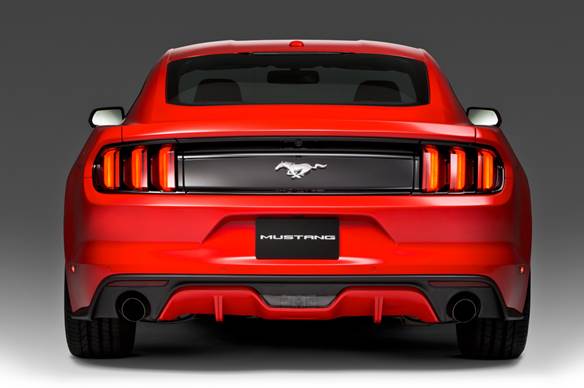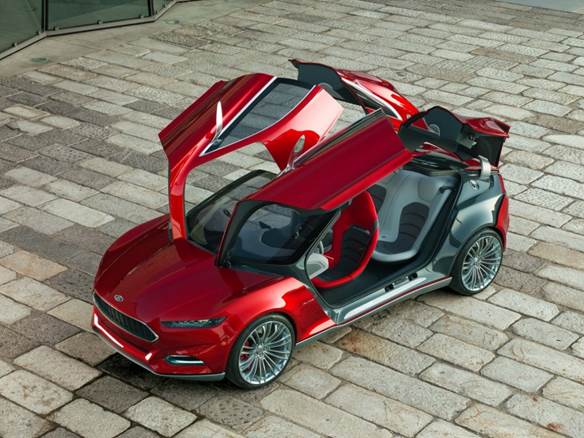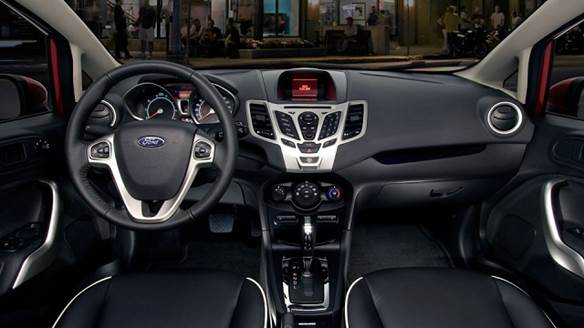Joel also amplified that fundamental of Mustang design, the long-hood/short-deck theme. This was done by moving the base of the windshield rearward 30 mm. Ford calls this the dash-to-axle appearance and it does accentuate the Mustangs muscularity. At the other end of the car, the trunk lid was lowered a tremendous 70mm, the better to “plant the car to the ground.”

Angled tri-bar
Of course, nothing beats a lowered roofline to visually mate the car to the pavement, and here the chop is subtle – and augmented by the lower bodywork rising 20mm higher than before. As for the recessed channel in the roofline, that’s not to suggest a Double Bubble from an Italian exotic or a Cobra Daytona Coupe’s Gurney Bubble. Joel put it there to keep the center of the roof from arching too high. This is an issue with first-generation Mustang fastbacks – seen from the three-quarter front they can have an odd fore-head bulge in the roofline that the S550′s roof channel eliminates.
Of course, to most enthusiasts, a Mustang’s general shape is one thing, but it’s the cues and jewelry that sets most tongues to wagging. Here Joel had an unexpected need – to remove Mustang cues. After 50 years of Mustangs, there’s a closet full of ways to dress the pony car, from running horses to C-scoops, tri-bar tail-lamps to center rear gas caps, hockey sticks to shaker hoods, slatted rear windows to fog-lights in the grille, and on and on. No Mustang needs all of these cues, and the newest version needs room to contribute its own to Mustang heritage. As Joel put it, “As we designed the vehicle we tried to edit some of the characteristics. We actually ended up taking off a number of the design cues just to see how far we could remove elements before it wasn’t a Mustang anymore.”

One of these could be controversial. “[The] hockey stick is not there. It is implied in the filet.” We’ll give Joel his due here. As much as we missed it on the S197 until Ford returned it to the mix, the at-best vestigial hockey stick – that’s the rise in the rear fender top crease just behind the doors – on the ’15 is OK with us. The car doesn’t need the hockey stick to say Mustang, and to have it there would likely have been more business than progress.
In the end, it’s that word, progress that most elegantly sums up the ’15 exterior design. Recalling the late-in-the-game rear fender widening headaches, Joel said, “We paid a lot of attention to the right size and right proportion of this vehicle from a standpoint of progressing the aesthetic of Mustang into a modern vernacular. That really came with the support of Dave’s [Pericak] team to help us re-architect the car to give it dynamic proportions.”

To that we’ll add the ’15 is destined to be a Mustang classic, a land-mark in the evolution on the car at a critical time. Rendered clumsily, the ’15 Mustang could have set the brand on a downward spiral no amount of reworking could have put right. But gracefully sculpted as it is, the ’15 is taking our favorite car strongly into the future.
Specifications Year: 2015 Make: Ford Model: Mustang Engine: V6 Transmission: Six-Speed Manual (Est.) Horsepower @ RPM: 300 (Est.) Torque @ RPM: 270 (Est.) Displacement: 3.7 L 0-60 time: 6 sec. (Est.) Top Speed: 155 mph (Est.) |